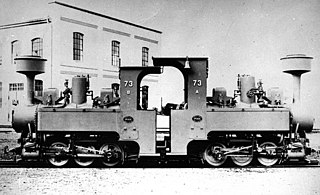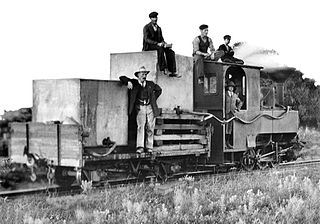
Under the Whyte notation for the classification of steam locomotives, 0-4-0 represents one of the simplest possible types, that with two axles and four coupled wheels, all of which are driven. The wheels on the earliest four-coupled locomotives were connected by a single gear wheel, but from 1825 the wheels were usually connected with coupling rods to form a single driven set.
R and W Hawthorn Ltd was a locomotive manufacturer in Newcastle upon Tyne, England, from 1817 until 1885.

The South West African Zwillinge 0-6-0T of 1898 was a narrow gauge steam locomotive from the German South West Africa era.

The Cape Town Railway & Dock 0-4-0T of 1858 was a South African steam locomotive from the pre-Union era in the Cape of Good Hope, and the first locomotive in South Africa.

The Natal Railway 0-4-0WTNatal of 1858 was a South African steam locomotive from the pre-Union era in the Natal Colony.

The South African Railways Class E 4-6-4T of 1902 was a steam locomotive from the pre-Union era in the Colony of Natal.

The South African Railways Class NG1 0-4-0T of 1900 was a narrow-gauge steam locomotive from the pre-Union era in Transvaal.
The South African Railways Class NG7 2-6-0 of 1902 was a narrow gauge steam locomotive from the pre-Union era in the Cape of Good Hope.

The South African Railways Dock Shunter 0-4-0T of 1909 was a steam locomotive.

The Cape Town Railway & Dock 0-4-2 of 1860 was a South African steam locomotive from the pre-Union era in the Cape of Good Hope.

The Natal Railway 4-4-0T Perseverance of 1876 was a South African steam locomotive from the pre-Union era in the Colony of Natal.

The Cape Government Railways 2nd Class 4-4-0T of 1882 was a South African steam locomotive from the pre-Union era in the Cape of Good Hope.

The Cape Government Railways 0-6-0T back-to-back of 1876 was a South African steam locomotive from the pre-Union era in the Cape of Good Hope.

The Cape Government Railways 1st Class 4-4-0T of 1875 was a South African steam locomotive from the pre-Union era in the Cape of Good Hope.

The Cape Government Railways 3rd Class 4-4-0 of 1884 was a South African steam locomotive from the pre-Union era in the Cape of Good Hope.

The Cape Government Railways 0-4-0ST of 1873 was a South African steam locomotive from the pre-Union era in the Cape of Good Hope.

The Cape Government Railways 2-6-0ST of 1900 was a South African steam locomotive from the pre-Union era in the Cape of Good Hope.

The Cape Government Railways NG 0-6-0T of 1903 was a South African steam locomotive from the pre-Union era in the Cape of Good Hope.

South African steam locomotive tenders were classified by means of type letters and sometimes numbers, while locomotive specifications included a list of permissible tenders which could be used with each engine class.
The Cape Government Railways 4th Class 4-6-0TT of 1882 with Joy valve gear, was a South African steam locomotive from the pre-Union era in the Cape of Good Hope.


















